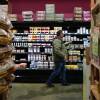Garland Wintzer says it is not easy being a Black bicyclist in Boston.
“Biking is seen as like a thing that white people do for fun and Black people do because they can't afford cars.” He says he gets nervous when riding past police. “Just because I'm a Black kid on an expensive nice bike. There are all those stereotypes about stealing bikes and stuff.”
Wintzer’s experience is not unique — across the region, Black cyclists say they face both discrimination and stuctural disadvantages that white riders don’t face, like a lack of safe riding lanes and less access to bike shops.
The lack of bike lanes, bike shops, and even bike racks is noticeable in communities of color across the country. Tamika Butler, former head of the LA county Bicycling Coalition, says there is a misperception that Black and brown people don’t ride as much as white people. But a 2012 report from the League of American Bicyclists found bicycling was increasing more in communities of color than it is in white communities. The report found that between 2001 and 2009 there was a 100% increase in African-Americans biking, and a 50% increase in Hispanics as compared to a 22% increase for whites.
“So, this idea that Black and brown folk aren't biking and that's why there's not infrastructure there because they're not using it, just isn't factually true,” Butler said in a recent panel discussion GBH hosted on racism in cycling. “It's because they're there, and they're Black and brown that resources aren't being invested there.”
Noah Hicks, owner of the bike shop Spokehouse in Dorchester, says COVID is driving a big increase in biking in minority communities. “People don't feel safe riding the subway right now, people don't feel safe riding on the trains and buses,” he said. “So, people who had not been riding before the pandemic are certainly starting to give it another look.”
When Hicks opened his bike shop seven years ago, it was the only bike shop for miles around. “The closest bike shop to me was about three miles away," he said. "Dorchester is huge. So that's not enough to service all of Dorchester.”

Hicks says there are still only two bike shops in Dorchester, and none in Roxbury, Mattapan or Hyde Park. By contrast, there are about 20 bike shops in other Boston neighborhoods, Cambridge and Somerville.
So why aren’t more people opening bike shops in Boston’s communities of color? “You have to have access to funding, which a lot of people from our community do not have,” Hicks said.
In addition, these communities often lack safe places to ride. Steve Snekvik of the biking organization Bikes not Bombs in Jamaica Plain said there is only one protected bike lane — marked by paint, construction cones or barrels or structures like Jersey barriers — in Dorchester, Roxbury, Mattapan and East Boston, though eight more have been proposed.
In the mostly white neighborhoods of Back Bay, the North End, Charlestown, Seaport and Fenway, there are five protected bike lanes with 14 more that are proposed, Snekvik said.
“That is a pretty big difference, especially when you look at the populations of these areas” he said. “Dorchester, Roxbury, Mattapan and East Boston have about three times the population of those other neighborhoods. And those communities are 70 percent Black and Hispanic compared to just 13 percent in the rest of Boston.
Last month, the first protected bike lanes as part of Boston’s new “Healthy Streets” initiative were delineated on the streets around Boston Common and the Public Garden. Lanes formerly used for parking were marked off with construction barrels and signs indicating they were to be used by cyclists only.
They may provide a safer way to bike in the downtown area but do little to connect to the outlying lower-income communities. Dedicated bike lanes being built in other parts of the city have not made it to Hicks’ neighborhood. “I'm looking at one of the busiest intersections in Dorchester out there right now. Columbia Road and Dudley Street, where we're located, doesn't even have a bike lane,” he said.
City planners say they have been listening and are beginning to act. The city has just installed the first designated bike lane in Mattapan along Cummins Highway and is working on a new project that would add protected bike lanes and traffic calming measures on American Legion Highway in Mattapan.
Not having safe bike lanes to ride in leads to more dangerous interactions between cyclists and motorists. And that has led to more confrontations with police. Angela Johnson-Rodrigues head of the Boston Cyclists Union say young cyclists of color in particular have a common complaint about police. “They’re being stopped at a greater frequency, that the police are very aggressive towards them,” she said.
Hicks says it's a familiar story: “I definitely hear it from young people all the time even when they get into crashes, and they have to report an accident. The treatment they receive is definitely not equal or satisfactory or acceptable.”
That means that beyond building new infrastructure, cyclists of color are seeking cultural change to eliminate the hazards of “biking while Black,” and to expand opportunities for communities of color to ride.





